Anacondas
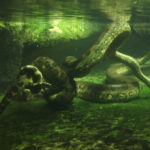
Some peoples’ nightmare, others’ delight, diving with anacondas deep in the heart of Brazil’s Pantanal wetland region is not for the fainthearted. These colossal reptiles and reach lengths of over 25 feet (8 m). And they can easily consume a capybara, a native South American mammal and the world’s largest rodent at up to 150 pounds (68 kg). In caiman and piranha-infested waters, divers will undertake the journey of a lifetime down the Rio Formoso, where they may see a jaguars and macaw along the riverbank. The gin-clear waters are best dived in the dry season from roughly April through November, as the rain loosens the silt-laden banks, dropping visibility to a few inches.
Sliding into the waters, the prehistoric-looking green anaconda lies on the shallow bottom, its whisky-brown scales glinting in the Amazonian sun. Occasionally its forked tongue flicks in and out, calm as can be. The anaconda, or sucuri, as Brazilians call it, is just as comfortable in the water as it is on the forest floor. Stay calm for your best chance at an extended encounter: despite their size, anacondas are quite shy around humans and will swim away if feeling threatened.
Belugas
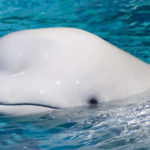
Just getting to the White Sea in Russia to dive with belugas is a mammoth task in itself. South of the famous Russian submarine base of Murmansk, the White Sea is a southern inlet of the Barents Sea, located on the northwest coast of Russia. It’s only sea in Europe to freeze annually, creating the perfect conditions for this unique cetacean. Belugas reside in the White Sea year-round, calving in the frigid waters and feeding on squid. The Arctic Circle Dive Center is your best shot for diving with them from late February to early April, although you must be a certified ice diver with 20 logged dives and at least four under ice. You’ll also need a drysuit certification.
The contrast between the dark, Arctic waters and the belugas’ stunning white skin often draws photographers from afar to shoot stunning images of these curious animals.
Snorkeling is another option for those who’d like to see belugas underwater but don’t have the training or time to journey to Russia’s far reaches. Each summer in Churchill, Manitoba, Canada, several operators offer the opportunity to slip into the water beside these friendly whales who inhabit Hudson Bay by the thousands each summer. These curious whales will often bring their young quite close to check you out, making for the experience of a lifetime. Operators will outfit you in either a thick wetsuit (up to 14 mm on your core) or a drysuit so you’ll stay warm during the roughly three-hour encounters.
American Crocodiles
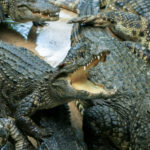
Banco Chinchorro, an atoll reef lying 20 nautical miles off the Yucatan Peninsula is one of the best — if not the premier — locations to snorkel with American crocodiles. Warm and shallow Caribbean waters offer fantastic visibility to encounter giants, which can reach lengths of up to 15 feet (4.5 m) and weigh 2,000 pounds (907 kg).
You’ll begin your trip in the small fishing village of Xcalak, where you can do a few dives before heading out to Chinchorro. At the bank itself, a small collection of fishing shacks represents the only human inhabitation. You’ll stay in a small wooden hut suspended above the shallow reef, offering remarkable access to the crocodiles each day. Diving is not permitted, but the shallow the reed beds mean that snorkel encounters will be just as memorable. Despite their fearsome reputation, these crocodiles are relatively docile, allowing photographers to approach within mere inches.
Marine Iguanas
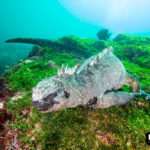
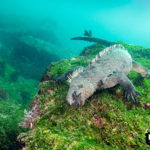
The waters surrounding the Galapagos Islands hold all manner of wonders, from whale sharks to schooling hammerheads. But one of the area’s most unique underwater residents is the endemic marine iguana, which you can see on snorkel or a shallow-water scuba dive. The best place to spot these prehistoric-looking lizards is at Cabo Douglas on the northeastern corner of Fernandina Island. The iguanas here have learned to dive into the chilly waters to feed on the marine algae that covers the underwater rocks. In depths of only 15 feet (4.5 m) a dive with them is like an extended safety stop.
In the early morning, you’ll see them sunning themselves on the shoreline, and the best time to dip in the water with them is mid-morning, once they’ve had a chance to warm up. They can hold their breath for up to 15 minutes while they’re feeding, clinging to the jagged rocks with their sharp claws. Approach slowly and give the animals room to feed, as sudden movements or encroaching on their space can cause them to let go and swim for another location. If you’d like to see marine iguanas, choose a Galapagos liveaboard that includes Cabo Douglas on the itinerary.
The post Unique Animals to Scuba Dive With appeared first on Scuba Diver Life.
from Scuba Diver Life https://ift.tt/2wX6dX6
No comments:
Post a Comment